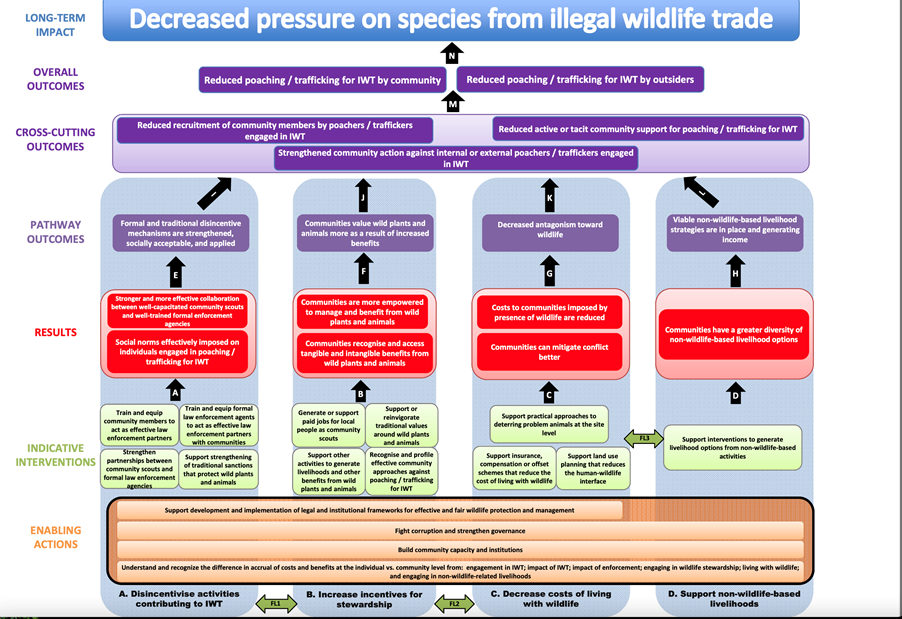Published in January 2022
This module is a resource for lecturers
Introduction
This module provides an overview of how supporting sustainable livelihoods and promoting community engagement may assist in preventing and combating wildlife crime. The term “wildlife,” for the purpose of this module, includes all species of wild flora and fauna. Hence, the term “wildlife crime” also encompasses forest crime and crimes in the fisheries sector. The focus on communities and sustainable livelihoods is in line with one of the four pillars of the intergovernmental conferences held in Kasane, Hanoi and London to reduce illegal trade in wildlife. The other pillars are law enforcement (compare with Module 3 of the Wildlife Crime series), legal frameworks (compare with Module 2 of the Wildlife Crime series), and demand reduction (compare with Module 1 of the Wildlife Crime series). While the latter are traditional and often state-centred responses, the community-focused approach is seen as part of a whole-of-society response that incorporates strategic cooperation and engagement of civil society. Proponents of this community-focused approach regard local communities living near protected areas, forests and fisheries as fulcrum institutions and individuals that hold the key to conserving natural resources for future generations. The module will discuss how sustainable livelihoods and community engagement in conservation may not only assist in addressing crime but can also lead to crime prevention. This module can be taught on its own but offers a more comprehensive view of wildlife crime when used in combination with Modules 1-3 of the Wildlife Crime series.
Learning outcomes
After a successful completion of this module, students will have:
- a better understanding of the broader social, economic and political context in which indigenous peoples and local communities (IPLCs) interact with ecosystems;
- an appreciation of the complex relationships between the state, private sector, other conservation actors and IPLCs;
- grasp the meaning of community involvement, engagement and co-management;
- an ability to critically examine community involvement in wildlife crime and responses thereto;
- an in-depth understanding of why local communities are crucial actors in turning the tide against wildlife crime;
- an enhanced understanding of why and how historic and current exclusion of IPLCs from protected areas and linked governance, management and benefit schemes is undermining biodiversity conservation;
- an appreciation of the difference between preventative and reactive crime fighting strategies;
- a general understanding of key community-focused initiatives in the conservation space and their strengths, weaknesses, controversies and opportunities;
- the ability to identify and locate relevant research and policy articles and critically engage with research reports and scholarly literature relating to sustainable livelihoods and community responses to wildlife crime;
- the ability to apply insights from this module to conservation policies and practices.
To assist lecturers in navigating the module, a tableau is provided here to explain the structure (see the IUCN First Line of Defense pathways in Figure 1 below). The module structure is loosely based on the First Line of Defence Pathways (FLoD) on incentives shaping community attitudes and behaviour in relation to the illegal wildlife trade (Cooney, Roe, et al. 2017) and models aimed at diversifying community income beyond trophy hunting, photographic or eco-tourism (Roe et al. 2020). The module begins with the problem statement and terminology before delving into a history of communities and conservation, showing continuities between the past and present such as disenfranchisement, marginalisation and eviction of indigenous peoples and local communities (IPLCs). Other disincentives include the cost of living near protected areas and wildlife such as human-wildlife conflict and the loss of livelihoods. The next section looks at incentives for communities to get involved with wildlife trafficking. The module explores individual, community and structural drivers that may influence poaching decisions. Following on is a section on the impact of enforcement-based approaches to wildlife trafficking on IPLCs. The section on community-led responses to tackling wildlife crime showcases how enforcement responses impact IPLCs and includes case studies about involving IPLCs in wildlife crime prevention. The module then looks at mechanisms that facilitate community conservation and reduce wildlife crime. Thereafter, there are two sections that discuss failures, weaknesses and critiques of community conservation. The final two sections look at the effectiveness of community-led approaches and what further challenges may lie ahead in light of pandemics, biodiversity loss and climate change. Class exercises are included in a separate section.
Figure 1- Local communities: First Line of Defence in Combating Illegal Wildlife Trade (IUCN 2017)

 Next: Key issues
Next: Key issues
 Back to top
Back to top